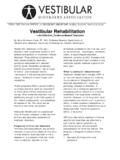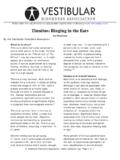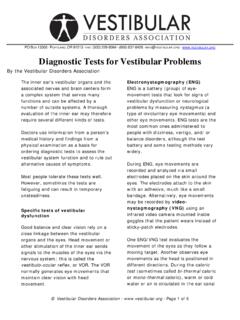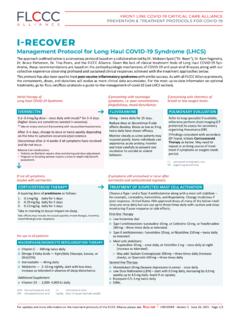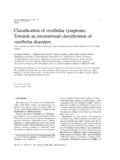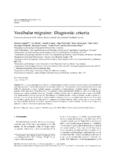Transcription of Benign Paroxysmal Positional Vertigo (BPPV)
1 vestibular Disorders Association Page 1 of 10 PO Box 13305 Portland, OR 97213 fax: (503) 229-8064 (800) 837-8428 Benign Paroxysmal Positional Vertigo (BPPV) By Timothy C. Hain, MD, Northwestern University Medical School, Chicago, Illinois; and the vestibular Disorders Association Benign Paroxysmal Positional Vertigo (BPPV) is the most common disorder of the inner ear s vestibular system, which is a vital part of maintaining balance. BPPV is Benign , meaning that it is not life-threatening nor generally progressive.
2 BPPV produces a sensation of spinning called Vertigo that is both Paroxysmal and Positional , meaning it occurs suddenly and with a change in head position. Why does BPPV cause Vertigo ? The vestibular organs in each ear include the utricle, saccule, and three semicircular canals. The semicircular canals detect rotational movement. They are located at right angles to each other and are filled with a fluid called endolymph. When the head rotates, endolymphatic fluid lags behind because of inertia and exerts pressure against the cupula, the sensory receptor at the base of the canal.
3 The receptor then sends impulses to the brain about the head s movement. BPPV occurs as a result of otoconia, tiny crystals of calcium carbonate that are a normal part of the inner ear s anatomy, detaching from the otolithic membrane in the utricle and collecting in one of the semicircular canals. When the head is still, gravity causes the otoconia to clump and settle (Figure 1). When the head moves, the otoconia shift. This stimulates the cupula to send false signals to the brain, producing Vertigo and triggering nystagmus (involuntary eye movements).
4 Figure 1: Inner ear anatomy. Otoconia migrate from the utricle, most commonly settling in the posterior semicircular canal (shown), or more rarely in the anterior or horizontal semicircular canals. The detached otoconia shift when the head moves, stimulating the cupula to send false signals to the brain that create a sensation of Vertigo . vestibular Disorders Association. Image adapted by VEDA with permission from T. C. Hain. Types of BPPV vestibular Disorders Association Page 2 of 10 Subtypes of BPPV are distinguished by the particular semicircular canal involved and whether the detached otoconia are free floating within the affected canal (canalithiasis) or attached to the cupula (cupulothiasis).
5 BPPV is typically unilateral, meaning it occurs either in the right or left ear, although in some cases it is bilateral, meaning both ears are affected. The most common form, accounting for 81% to 90% of all cases, is canalithiasis in the posterior semicircular Symptoms In addition to Vertigo , symptoms of BPPV include dizziness (light-headedness), imbalance, difficulty concentrating, and nausea. Activities that bring on symptoms can vary in each person, but symptoms are precipitated by changing the head s position with respect to gravity.
6 With the involvement of the posterior semicircular canal in classic BPPV, common problematic head movements include looking up, or rolling over and getting out of bed. BPPV may be experienced for a very short duration or it may last a lifetime, with symptoms occurring in an intermittent pattern that varies by duration, frequency, and intensity. It is not considered to be intrinsically life-threatening. However, it can be tremendously disruptive to a person s work and social life, as well as pose a health hazard due to an increased risk of falls associated with dizziness and imbalance.
7 Causes BPPV is the most common vestibular disorder; of all people will experience it at some point in their BPPV accounts for at least 20% of diagnoses made by physicians who specialize in dizziness and vestibular disorders, and is the cause of approximately 50% of dizziness in older The most common cause of BPPV in people under age 50 is head injury and is presumably a result of concussive force that displaces the otoconia. In people over age 50, BPPV is most commonly idiopathic, meaning it occurs for no known reason, but is generally associated with natural age-related degeneration of the otolithic membrane.
8 BPPV is also associated with migraine3 and ototoxicity. Viruses affecting the ear (such as those causing vestibular neuritis) and M ni re s disease are significant but unusual causes. Occasionally BPPV follows surgery as a result of the trauma on the inner ear during the procedure combined with a prolonged supine (laying down face-up) BPPV may also develop after long periods of inactivity. vestibular Disorders Association Page 3 of 10 Figure 2a: Canalith repositioning procedure (CRP) for right-sided BPPV.
9 Steps 1 & 2 of CRP are identical to the Dix-Hallpike maneuver used to elicit nystagmus for diagnosis. The patient is moved from a seated supine position; her head is then turned 45 degrees to the right and held for 15-20 seconds. Diagnosis BPPV is diagnosed based on medical history, physical examination, the results of vestibular and auditory (hearing) tests, and possibly lab work to rule out other diagnoses. vestibular tests include the Dix-Hallpike maneuver (see Figure 2a) and the Supine Roll test. These tests allow a physician to observe the nystagmus elicited in response to a change in head position.
10 The problematic semicircular canal can be identified based on the characteristics of the observed nystagmus. Frenzel goggles, especially of the type using a TV camera, are sometimes used as a diagnostic aid in order to magnify and illuminate nystagmus. If electronystagmography (ENG) is em-ployed to observe nystagmus with position changes, it is important that the equipment used is capable of measuring vertical eye movements. A physician may also order radiographic imaging such as a magnetic resonance imaging scan (MRI) to rule out other problems such as a stroke or brain tumor, but such scans are not helpful in diagnosing In addition, a physician may order auditory tests to help pinpoint a specific cause of BPPV, such as M ni re s disease or labyrinthitis.

